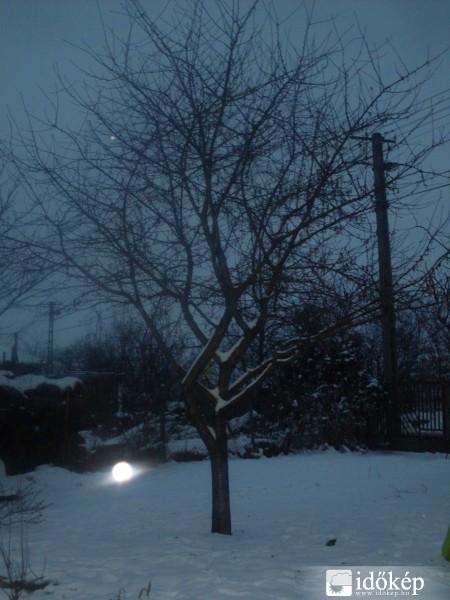Ball lightning is an atmospheric electrical phenomenon of which little is known. The term refers to reports of luminous, usually spherical objects which vary from pea-sized to several metres in diameter. It is usually associated with thunderstorms, but lasts considerably longer than the split-second flash of a lightning bolt. Many of the early reports say that the ball eventually explodes, sometimes with fatal consequences, leaving behind the odor of sulfur. There are records of free-floating glowing balls that occur in total absence of thunderclouds (Wikipedia).
Ball lightning was menationt already in the ancient times, but is still a mistery. Novadays more pictures are prepared (mainly by mobile-phones) and published on the net. Originality of some of these photos is questionnable. The picture introduced here was taken in January 2011, in Hungary, close to Budapest. It has been investigated by experts who say it is original and a very good quality one, in contrast to the most ones.
A serious ball-lightening case is also introduced by another picture: 100 cows were prostrated and 17 of them also killed in 2001, at the village Büssü, Hungary.
Some characteristics of ball-lightenings are summarized here:
A review identified the properties of a “typical” ball lightning, whilst cautioning against over-reliance on eye-witness accounts:
- They frequently appear almost simultaneously with cloud-to-ground lightning discharge
- They are generally spherical or pear-shaped with fuzzy edges
- Their diameters range from 1–100 cm, most commonly 10–20 cm
- Their brightness corresponds to roughly that of a domestic lamp, so they can be seen clearly in daylight
- A wide range of colors has been observed, red, orange and yellow being the most common.
- The lifetime of each event is from 1 second to over a minute with the brightness remaining fairly constant during that time
- They tend to move, most often in a horizontal direction at a few metres per second, but may also move vertically, remain stationary or wander erratically.
- Many are described as having rotational motion
- It is rare that observers report the sensation of heat, although in some cases the disappearance of the ball is accompanied by the liberation of heat
- Some display an affinity for metal objects and may move along conductors such as wires or metal fences
- Some appear within buildings passing through closed doors and windows
- Some have appeared within metal aircraft and have entered and left without causing damage
- The disappearance of a ball is generally rapid and may be either silent or explosive
- Odors resembling ozone, burning sulfur, or nitrogen oxides are often reported
There are many laboratory evidences on ball-lightenings and their creation; starting from the popular shows of Nikola Tesla (1856−1943), through the experiments of the Research Institute Max Planck until the home-made experiments in microwave ovens. In the kitchen microwave oven small rising glowing balls (called also plasma)can be produced by placing a lit or recently extinguished match or other small object in a microwave oven. The burnt portion of the object flares up into a large ball of fire, while "plasma balls" can be seen floating near the ceiling of the oven chamber. Some experiments describe covering the match with an inverted glass jar, which contains both the flame and the balls so that they will not damage the chamber walls.
(1) http://anotherlife2time.qwqw.hu/?modul=blog&a=62712
(2) http://www.idokep.hu/hirek/gombvillamot-fotoztak-ball-lightning
(3) http://www.hetek.hu/fokusz/200107/villamlatogatas
(4) http://en.wikipedia.org/wiki/Ball_lightning
